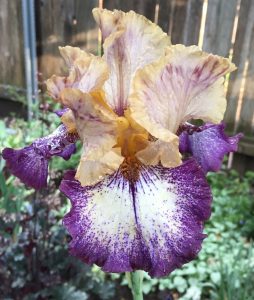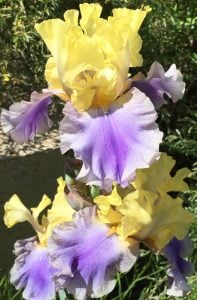German bearded irises are ideally suited to dry conditions in bright sun; they’re easy-to-grow perennials, with a fleeting but fabulous early-summer blossom time.
Each May for the past few years, I accompany my best-beloved to MahlerFest, held at the Boulder campus of the University of Colorado. It’s taken me a more than a moment to wrap my head around the maestro’s work, but the last couple of festivals were terrific because, while he listened to the a performance of the 8th for the ‘enth time, I sloped off to visit some nurseries. Top of the list is Long’s Gardens. Once a seed supply and multi-variety nursery, they now are known as an iris nursery that grows and breeds a wide selection of German bearded irises. I’m a sucker for a tall stemmed flower, especially when it is as blowsy and florid as some irises.
In business since 1905, Long’s is today owned and operated by the third generation of the same family. Handily, MahlerFest coincides with iris-flowering time, and approaching the field-grown plants is like a virtual-reality trip to Giverny (Monet did a mean job depicting the voluptousness of iris blooms).

What appeals to me most about Long’s, apart from the obvious, is that the plants are sold on a dig-your-own basis. So, see the flower your heart desires, identify the clump you want, and fork in hand, gently lift it from its neighbors. Before the era of pot-grown perennials, this is how plants were sold, straight from the field to the garden: Economical, enviro-friendly, and just a beautiful way to shop for plants.

Irises do extraordinarily well in in the high plains, loving the gritty, sandy soil and the lurid sunshine that ripens the rhizomes perfectly. Once I get the plants home, cut their foliage back to tidy fans and put them firmly into the ground, they romp away. Later, flower stalks removed, the silvery grey foliage looks okay as it blends discreetly among the penstemons, grasses and agastache, all of which are airey-fairy, so the swords of the iris foliage are a good sturdy foil. To feed the plants, Long’s recommends alfalfa meal; I’ve known gardeners who swear by a dose of epsom salts after flowering, but in the minerally soil of my garden I reckon the meal will be a better choice.
My iris collection grows, supplemented by starts taken from the iris bed in the garden at my son’s newly purchased house. The raised bed is the size of a bocce court, and packed with irises of every color, solids and bicolors. He and his wife are not gardeners – yet – but enough ooohing and ahhing from Mom has encouraged them.

So this past week we set about thinning out the rhizomes, some of which I added to my garden, others we left by the curb, “Free Iris Plants – Help Yourself’’. They were gone in minutes: turns out the previous owner was known for his collection. Turns out, too, that there was a renowned iris breeder here in town, Dr. Philip Loomis. He hailed from Chicago, but contracted tuberculosis sometime in the early 1900s. That brought him to the Springs for the curative powers of the arid climate. He stayed on, developed a practice as cardiologist, then took up iris breeding. ‘Blue Velvet’, introduced in 1929, was his first. ‘Elmohr’, in 1949, his most successful introduction (it’s everywhere!) and Flopsy, a late introduction with flattened flowers – it looks almost like a gardenia, and though scented, is not as perfumed as one. I purchased a plant from Long’s, so look forward to next season’s bloomtime.
Loomis, who died in 1970 won many awards for his irises, one of which, ‘Seashells’ was shown at the 1933 “Century of Progress” as the Chicago World’s Fair that year was known. Today, Loomis is commerated by the Loomis Memorial Iris Trial Gardens at the East Library Branch in Colorado Springs, and at 6000 feet plus, is the only public, high-altitude trial garden for irises. The garden is maintained by the Elmohr Iris Society and open to the public. It’s not extensive, but when in flower will knock your socks off.

©Ethne Clarke, text and photographs, 2016.


